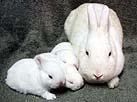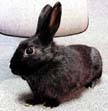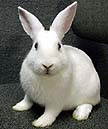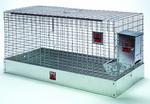HOUSING * RABBITS DON'T NEED A LOT OF ROOM
Adequate ventilation is a must regardless of what type housing you use. Respiratory diseases can arise without good air flow. Make sure at least a portion of the cage or hutch is constructed of wire mesh to allow for good air flow.
Cage Sizes:
Size will vary according to the size of your rabbit.
Recommended size for 1 doe and her litter:
Small Breeds 2-4 lbs - 30 X 30 X 12 high
Medium Breeds 5-7 lbs - 30 X 36 X 12-14 high
Large Breeds 8+ - 30 x 40-48 x 14-16 high
FEEDING YOUR RABBIT
- Feed should be placed in spill-proof bowls or self-feeders.
- Rabbits will not eat pelleted feed containing a lot of dust
- Grass hay should be available to your rabbits at all times. The fiber in hay promotes normal digestion and prevents hairballs.
- Pelleted feed should contain at least 16% fiber. Always store pellets in an air tight container to preserve freshness and keep rodents, etc. out. Old, rancid feed can cause a rabbit to stop eating.
- Limited treats may be given. When fed as directed, many rabbit feeds are complete and balanced. Therefore, feeding additional treats and/or vitamin or mineral supplements is not recommended as this can creat an imbalance in the rabbit's nutrition. Additional salt may also be unnecessary as the feed may contain all the salt required for normal health.
- Feeding guideline:
Small Breeds - 2-3 ounces per day.
Medium Breeds - 3-5 ounces per day
Large Breeds - 5-8 ounces per day
The amount of feed required depends upon many factors such as stage of reproduction, activity levels and environment. Feeding rates should be adjusted to maintain the desired body condition.





HOT AND COLD
Rabbits are better able to withstand the cold than summer's heat. Protected from drafts, rabbits can withstand temperatures below zero. Enclose both sides and the back of the cage or hutch with clear plastic draped from the top of the hutch to three inches off the ground. A burlap flap should be placed along the front of the cage, this will keep drafts out while allowing for a mild exchange of fresh air.
Rabbits do not do well in high temperatures. A rabbit's optimal air temperature ranges from 50 to 70 degrees F. Rabbits can over-heat rather quickly, and are uncomfortable at temperatures above 83 degrees F. Even rabbits who are kept inside can be susceptible to heat-related stress if air conditioning is not available.
Outdoors - Be sure your hutch has plenty of shade. Freeze a gallon milk jug full of water and place inside a large bowl (this keeps the condensation away from the rabbit) in the rabbit's cage. Most rabbits will lie down next to the cool bowl. Large ceramic tiles also work...place them in the freezer and place in the cage for the rabbits to lie down on.
Indoors - Use a fan to help cool the rabbit. Be sure it is placed so that the rabbit can't chew
the cord. You can also immerse a light cloth in cool water and hang it over the side of the
cage or pen and allow the fan to blow on the cloth. The frozen milk jug and tiles will also work for indoor rabbits.
Overheating in rabbits should be considered an emergency and immediate steps must be taken to prevent death. The normal rectal temperature for a rabbit is 100-103 F. Watch your rabbit for panting, lethargy or warm to the touch. Consult your veterinarian if your rabbit's temperature is above normal or it shows signs of heat stress.
RABBIT BASICS
- The average life span of a rabbit is 6 years. Good care and a healthy environment can add 4+ years to your rabbits life.
- First-time mothers should be monitored as they often have poor mothering instincts. This generally improves after their first litter.
- Good air quality is important to the well-being of rabbits. Fresh air is a must. Ammonia build-up or high moisture content can lead to respiratory problems.
- Water is their most important nutrient. Rabbits drink twice as much water as they eat. If they do not drink, they won't eat.
- Protect your rabbits from cold drafts and wet blowing winds.
- Rabbits should be fed hay free-choice.They need the fibrous roughage in their diet in order to maintain a healthy digestive system.
- Feeding programs should be designed based on breed, management, sex, environment and genetic potential.
- The gestation period for rabbits range from 30-32 days.
HANDLING YOUR RABBIT
A rabbit should never be picked up by the ears.
Damage to the ear tissue can be caused this way and it is painful for the rabbit.
Pick up a rabbit by the fold of skin above the shoulders with one hand supporting the hind quarters. Or lift the animal from underneath, while providing support to the hindquarters, allowing the rabbit to rest on your stomach with all four feet against you.
WATER IS YOUR RABBIT'S BEST FRIEND
Fresh water should be available to your rabbit at all times. Water can be provided in a spill-proof dish or preferably a water bottle specially designed for rabbits. Whichever method is used, routine cleaning of the utensil is important to insure you maintain quality water.
Flooring:
Self-cleaning cages where fecal and urine matter drop through, have a floor made of wire mesh or grid that forms squares. It is important to provide some type of catch tray or method of collecting the rabbit's waste. Trays can be lined with paper, wood shavings or other absorbent material. Adding a small amount of baking soda to the litter will help eliminate odors.
Some portion of the cage floor should be solid to help prevent the rabbit's feet from becoming sore.
Cages must be cleaned frequently to prevent odors and disease. A good cleaning/disinfecting solution for utensils, equipment and cages is 1 tablespoon of household bleach mixed in 1 quart of water. Scrub and rinse well.
Droopings should not be allowed to accumulate under the cage. They should be raked up weekly.
RABBITS | Care and Handling

Web Site Design by S&J Enterprises - Homestead Website Design

